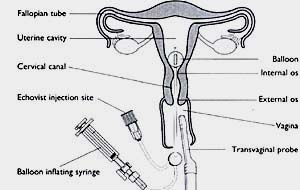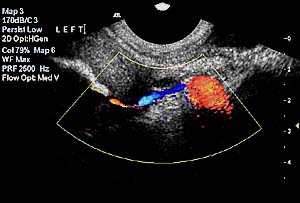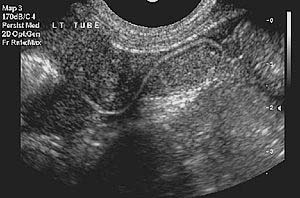Hysterosalpingo-Contrast-Sonography (HyCoSy)
The causes of infertility
Infertility affects up to 10% of couples in the Western World and 20-40% of these these cases may be due to previous abdominal surgery or infection of the fallopian tube.
Management of tubal disease
The management of tubal (Fallopian) disease as a cause of infertility has changed dramatically in recent years. This is largely due to the rapidly improving results of assisted conception through in-vitro fertilization (IVF) compared to the disappointing results achieved through tubal microsurgery.
The function of the Fallopian tube
The ovary produces the egg and it needs to meet the sperm if pregnancy is to eventuate. After fertilization occurs, the embryo must progress to the uterine cavity, where it implants. If the tube is blocked, then the egg and sperm will not meet. If the embryo, after fertilization, does not pass through the tube at the normal rate, then it can implant in the Fallopian tube. This is called an ectopic pregnancy.
History
Prior to the development of HyCoSy, routine investigation of tubal patency (whether the tubes are blocked or clear) through hysterosalpingography (HSG) and laparoscopy with dye was expensive, time consuming and unpleasant for the patient as these involved the use of surgery, general anaesthesia, hospitalization as well as ionizing radiation.
HyCoSy explained
Hysterosalpingo-contrast-sonography (HyCoSy) is a transvaginal ultrasound technique in which a solution of galactose and 1% palmitic acid (Levovist) - or a mixture of air and saline - is infused into the uterine cavity and observed to flow along the Fallopian tubes to assess tubal patency. The bright echoes generated by the Levovist makes tubal visualization easier, which is further improved by the addition of colour Doppler imaging.
Why HyCoSy?
In recent years HyCoSy has increasingly been used in preference to hysterosalpingography (HSG) and apparels as a first line investigation for infertility because of its convenience and safety. HyCoSy also allows examination of the other pelvic organs and because it is a dynamic study and can give valuable information regarding tubal function.
|
 |
| Diagram of the HyCoSy procedure |
 |
| Colour doppler imaging of the fallopian tube during HyCoSy |
|
Scientific studies
Campbell reviewed the European experience with HyCoSy in 1994, showing that the results were very operator dependent. There have been numerous small studies published, largely from Germany, confirming results comparable to HSG in accuracy for tubal patency.
Is there any discomfort?
There can be mild discomfort associated with this procedure, particularly if the Fallopian tubes are blocked. Taking an analgesic such as Naprogesic (two tablets) half an hour before the procedure is recommended.
Summary
HyCoSy provides a low-risk, outpatient procedure that is of comparable accuracy to HSG, indicating which direction further diagnosis and treatment of infertility should take. This technique, along with transvaginal ultrasound, is an ideal screening test for tubal patency in the investigation of infertility.





